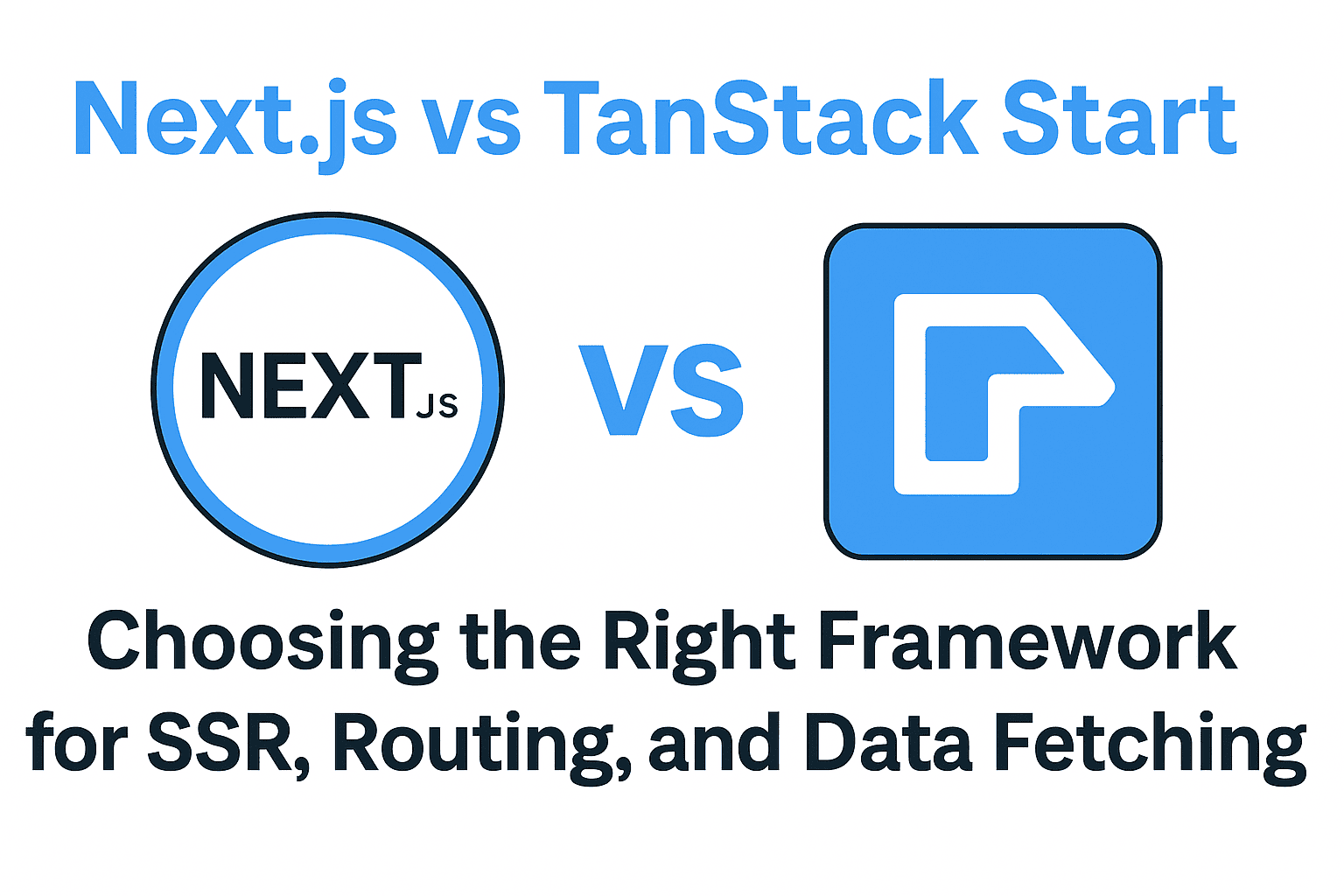Developers today have two powerful contenders for building modern React applications: Next.js and TanStack Start. Both bring unique approaches to server-side rendering (SSR), routing, and data fetching, but their philosophies differ significantly.
In this guide, we’ll dive deep into the differences — with examples — so you can make an informed decision.
Why Compare Next.js and TanStack Start?
- Next.js is a production-ready, opinionated framework backed by Vercel. It emphasizes convention over configuration.
- TanStack Start (built on TanStack Router and TanStack Query) is newer, more flexible, and optimized for data-first workflows.
If you’re searching “should I use Next.js or TanStack Start?” or “TanStack Start vs Next.js for SSR” — this article will help.
Server-Side Rendering (SSR) and Streaming
Next.js
Next.js supports multiple rendering modes:
// Example: Next.js App Router
// app/page.tsx
export default async function Home() {
const res = await fetch("https://api.example.com/posts", {
cache: "no-store", // forces SSR
});
const posts = await res.json();
return (
<main>
<h1>Latest Posts</h1>
<ul>
{posts.map((p) => (
<li key={p.id}>{p.title}</li>
))}
</ul>
</main>
);
}
- cache: 'no-store' forces SSR
- cache: 'force-cache' enables SSG
- ISR (Incremental Static Regeneration) allows background updates
TanStack Start
TanStack Start uses streaming SSR by default, tightly coupled with React Router v7.
// Example: TanStack Start loader + component
import { createFileRoute } from "@tanstack/start";
export const Route = createFileRoute("/")({
loader: async () => {
const res = await fetch("https://api.example.com/posts");
return res.json();
},
component: ({ data }) => (
<main>
<h1>Latest Posts</h1>
<ul>
{data.map((p) => (
<li key={p.id}>{p.title}</li>
))}
</ul>
</main>
),
});
Notice how data loading happens at the route level, making SSR and client hydration seamless.
Routing: File-Based vs Config-Based
Next.js Routing
Next.js uses file-system routing:
app/
├─ page.tsx → `/`
├─ about/page.tsx → `/about`
└─ blog/[id]/page.tsx → `/blog/:id`
Dynamic routes like [id] are simple and intuitive.
TanStack Start Routing
TanStack Start uses programmatic routing with createFileRoute and createRootRoute.
import { createRootRoute, createFileRoute } from "@tanstack/start";
const rootRoute = createRootRoute({
component: () => <Outlet />,
});
const blogRoute = createFileRoute("/blog/$id")({
loader: async ({ params }) => {
return fetch(`/api/blog/${params.id}`).then((res) => res.json());
},
component: ({ data }) => <h2>{data.title}</h2>,
});
- Pros: More flexible for nested, dynamic, and conditional routes
- Cons: More verbose than Next.js file-based approach
Data Fetching: API Handlers vs Query-First
Next.js
Next.js offers multiple APIs:
- Server Components fetch (App Router)
- getServerSideProps (SSR)
- getStaticProps (SSG)
// Example with Server Component
export default async function Post({ params }) {
const post = await fetch(`https://api.example.com/posts/${params.id}`).then(
(res) => res.json()
);
return <article>{post.title}</article>;
}
TanStack Start
TanStack Start is built on TanStack Query principles:
export const Route = createFileRoute("/posts/$id")({
loader: async ({ params }) => {
return fetch(`/api/posts/${params.id}`).then((res) => res.json());
},
component: ({ data }) => <article>{data.title}</article>,
});
This ensures data fetching, caching, and revalidation are consistent across server and client.
Performance Considerations
Next.js:
- Excellent with ISR + Vercel Edge Functions
- Sometimes requires tuning (e.g., cache, revalidate)
TanStack Start:
- Streaming-first SSR ensures fast TTFB
- Route-level caching avoids redundant fetches
SEO Differences
- Next.js: Battle-tested for SEO, with full control over
<head>via metadata or next/head. - TanStack Start: Provides SEO primitives via route metadata, but ecosystem is still growing.
Both frameworks support server-side rendering of meta tags, which is crucial for SEO.
When to Choose Each
✅ Choose Next.js if:
- You want a mature ecosystem with wide adoption
- You prefer file-based routing and conventions
- You deploy on Vercel and want plug-and-play DX
✅ Choose TanStack Start if:
- You need granular control over routing and data fetching
- You’re already using TanStack Query
- You want to embrace streaming-first SSR
Conclusion
The Next.js vs TanStack Start debate isn’t about which is “better” — it’s about fit.
- Next.js = stability, ecosystem, conventions
- TanStack Start = flexibility, cutting-edge data-first SSR
If your team values convention and speed to production → Next.js.
If you want flexibility and a unified SSR/data model → TanStack Start.
👉 Pro Tip: Try building the same simple app in both frameworks (e.g., a blog with SSR + dynamic routes). You’ll quickly see which aligns better with your workflow.
🤝 Need a Custom RSVP System or Dashboard?
I help businesses build tools that actually work — even on tight deadlines.
Whether you're planning an event, need internal tools, or want a custom dashboard for your team — I can help.
Reach out
📧 Email: safi.abdulkader@gmail.com | 💻 LinkedIn: @abdulkader-safi | 📱 Instagram: @abdulkader.safi | 🏢 DSRPT
Drop me a line, I’m always happy to collaborate! 🚀



